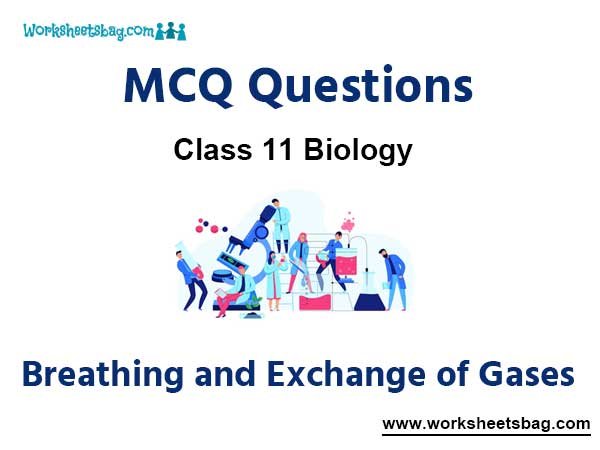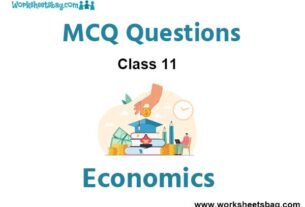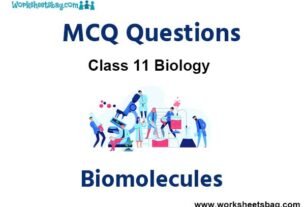Please refer to Breathing and Exchange of Gases MCQ Questions Class 11 Biology below. These MCQ questions for Class 11 Biology with answers have been designed as per the latest NCERT, CBSE books, and syllabus issued for the current academic year. These objective questions for Breathing and Exchange of Gases will help you to prepare for the exams and get more marks.
Breathing and Exchange of Gases MCQ Questions Class 11 Biology
Please see solved MCQ Questions for Breathing and Exchange of Gases in Class 11 Biology. All questions and answers have been prepared by expert faculty of standard 11 based on the latest examination guidelines.
MCQ Questions Class 11 Biology Breathing and Exchange of Gases
Question- Which of the following statements is incorrect for ECG of human heart?
(a) It is graphical representation of the electrical activity of the heart during a cardiac cycle.
(b) The ECG of a person is obtained by using a machine called electrocardiogram.
(c) To obtain a standard ECG a patient is connected to the machine with three electrical leads.
(d) Each peak in the ECG is identified with a letter from P to T that corresponds to a specific electrical activity of the heart.
Answer
B
Question– Select the correct statement.
(a) Inter-atrial septum is a thick partition while atrio-ventricular partitions are thin.
(b) Mitral valve is having 2 fibrous nonmuscular cusps.
(c) Size of heart is equivalent to the size of clenched fist.
(d) All of the above.
Answer
C
Question– The correct order of duration of various phases of the cardiac cycle is:
(a) Atrial systole < Ventricular systole < Joint diastole < Ventricular diastole < Atrial diastole
(b) Atrial systole < Ventricular diastole < Joint diastole < Ventricular systole < Atrial diastole
(c) Atrial diastole < Ventricular diastole < Joint diastole < Ventricular systole < Atrial systole
(d) All of the above
Answer
A
Question– The blood stem cells are related to which among the following options:
(a) Liver
(b) Spleen
(c) Kidney
(d) Bone marrow
Answer
D
Question– The net pressure gradient that causes the fluid to filter out from the glomeruli into the capsule is-
(a) 50 mm Hg
(b) 75 mm Hg
(c) 10 mm Hg
(d) 30 mm Hg
Answer
C
Question– The nephridia of earthworm are related with :-
(a) Locomotion
(b) Excretion of nitrogenous wastes
(c) Digestion
(d) Respiration
Answer
B
Question- Angiotensin –II will lead to all of the following except :-
(a) Vasoconstriction
(b) Hypernatremia
(c) Increasing GFR
(d) Excretion of Na+ in urine
Answer
D
Question- Which of the following is incorrect match about human excretory system?
(a) Columns of Bertini: extension of cortex in between the renal pyramids.
(b) Renal corpuscle: Bowman’s capsule plus glomerulus.
(c) Cortical nephrons: Vasa recta is absent or highly reduced.
(d) Podocytes: Cuboidal epithelium of Bowman’s capsule.
Answer
D
Question- Which of the following statements about the functioning of the kidney is correct?
I. On an average 1100-1200ml of blood is filtered by the kidneys per minute which constitute roughly 1/5th of the blood
pumped out by each ventricle of the heart in a minute.
II. JGA is a special sensitive region formed by cellular modification in the distal convoluted tubule and the glomerulus at the location of their contact.
III. The ascending limb of Henle’s loop is impermeable to water but allows transport of electrolytes.
IV. The collecting duct allows passage of small amounts of urea into the medullary interstitium to keep up the osmolarity.
(a) I and II
(b) I, III and IV
(c) I, II, and III
(d) II, III, and IV
Answer
B
Question- Which of these statements about sphincters of urethra is correct?
(a) Interal urethral sphincter is made up of smooth muscles while external urethral sphincter is made up of striated muscles.
(b) Interal urethral sphincter is made up of striated muscles while external urethral sphincter is made up of smooth muscles.
(c) Both internal and external urethral sphincters are made up of smooth muscles.
(d) Both internal and external urethral sphincters are made up of striated muscles.
Answer
A
Question- Identify the correct statements regarding urine formation?
(a) Countercurrent mechanism works around the PCT and glomerulus.
(b) To prevent diuresis ADH facilitates water reabsorption from the latter parts of the tubule.
(c) Maximum reabsorption of electrolytes occurs in the Henle’s loop.
(d) A decrease in blood pressure can increase the GFR.
Answer
B
Question- Which of the following substances are secreted by tubular cells into the filtrate during urine formation?
(a) Glucose, amino acid, Na+
(b) H+ , K+ , amino acid
(c) Na+ , K+ , amino acids
(d) K+ , H+ , ammonia
Answer
D
Question- A person with chronic kidney failure will have:
(a) High blood urea and high serum creatinine levels.
(b) High blood urea and low serum creatinine levels.
(c) Low blood urea and high serum creatinine levels.
(d) Low blood urea and low serum creatinine levels.
Answer
A
Question- Identify the correct statement with reference to transport of respiratory gases by blood ?
(a) Haemoglobin is necessary for transport of carbon dioxide and carbonic anhydrase for transport of oxygen.
(b) Haemoglobin is necessary for transport of oxygen and carbonic anhydrase for transport of carbon dioxide.
(c) Only oxygen is transported by blood.
(d) Only carbon dioxide is transported by blood.
Answer
B
Question- Asthma is caused due to
(a) infection of lungs.
(b) spasm in bronchial muscles.
(c) bleeding into pleural cavity.
(d) infection of trachea.
Answer
B
Question- The structure which prevents the entry of food into the windpipe is
(a) gullet
(b) glottis
(c) tonsil
(d) epiglottis
Answer
D
Question- The total lung capacity is represented by
(a) Tidal volume + Vital capacity
(b) Tidal volume + Residual volume
(c) Vital capacity + Residual volume
(d) Inspiratory + Expiratory reserve volumes
Answer
C
Question- Intercostal muscles are found attached with
(a) diaphragm
(b) ribs
(c) pleura
(d) lungs
Answer
B
Question- Membrane separating air in pulmonary alveoli from blood capillaries is
(a) alveolar epithelium
(b) cardiac epithelium
(c) endothelium of blood capillaries
(d) both (a) and (c)
Answer
D
Question- Which one of the following is the correct statement for respiration in humans?
(a) Workers in grinding and stone-breaking industries may suffer from lung fibrosis.
(b) About 90% of carbon dioxide (CO2) is carried by haemoglobin as carbaminohaemoglobin.
(c) Cigarette smoking may lead to inflammation of bronchi.
(d) Neural signals from pneumotaxic centre in pons region of brain can increase the duration of inspiration.
Answer
A
Question- The path that leads from the throat to the lungs is known as
(a) trachea
(b) oesophagus
(c) epiglottis
(d) larynx
Answer
A
Question- Respiratory mechanism is controlled by
(a) central nervous system
(b) sympathetic nervous system
(c) parasympathetic nervous system
(d) autonomic nervous system
Answer
A
Question- The total volume of air a person can expire after normal inspiration is called
(a) residual volume
(b) vital capacity
(c) expiratory capacity
(d) functional residual capacity
Answer
C
Question- Which of the following group are supported by incomplete cartilaginous rings?
(a) Pharynx, primary & tertiary bronchi and initial bronchioles.
(b) Trachea, primary & secondary bronchi, and initial bronchioles.
(c) Larynx, primary, secondary and tertiary bronchi, and initial bronchioles.
(d) Trachea, primary, secondary and tertiary bronchi, and initial bronchioles.
Answer
D
Question- When 1200 mL air is left in the lungs, it is called
(a) vital capacity
(b) tidal volume
(c) residual volume
(d) inspiratory reserve volume
Answer
C
Question- Partial pressure of oxygen in inspired and expired air is ……. and ……. mm of Hg.
(a) 100, 46
(b) 158, 40
(c) 158, 90
(d) 100, 95
Answer
B
Question- The volume of air breathed in and out during normal breathing is called
(a) vital capacity
(b) inspiratory reserve volume
(c) expiratory reserve volume
(d) tidal volume
Answer
D
Question- Mark the correct statement.
(a) Volume of residual air is higher than tidal volume.
(b) Volume of complementary air is higher than tidal volume.
(c) Volume of supplementary air is lower than residual capacity.
(d) All of the above
Answer
D
Question- Every 100 ml of oxygenated blood delivers following amount of O2 to the tissues under normal physiological contition.
(a) 5 ml
(b) 25 ml
(c) 50 ml
(d) More than 50 ml
Answer
A
Question- The structure which does not contribute to the breathing movements in mammals is
(a) larynx
(b) ribs
(c) diaphragm
(d) intercostal muscles
Answer
A
Question- The respiratory centre, which regulates respiration, is located in
(a) cerebral peduncle
(b) vagus nerve
(c) pons varolii
(d) medulla oblongata
Answer
D
Question- What percentage of oxygen is carried by haemoglobin ?
(a) 90
(b) 98
(c) 23
(d) 73
Answer
B
Question- Which of the following statement is correct?
(a) Tracheal rings are of hyaline cartilage .
(b) Dorsal side of thoracic chamber is formed by sternum.
(c) Expiration occurs when there is negative pressure in lungs.
(d) All of the above
Answer
A
Question- Functional residual capacity can be represented as
(a) TV + ERV
(b) ERV + RV
(c) RV + IRV
(d) ERV + TV + IRV
Answer
B
Question- Most oxygen is carried by the blood __(i)__. Most carbon dioxide is carried by the blood __(ii)__.
(a) (i) attached to haemoglobin. (ii) in the form of bicarbonate ions.
(b) (i) dissolved in plasma . (ii) dissolved in plasma.
(c) (i) in the form of H+ ions . (ii) in the form of bicarbonate ions.
(d) (i) attached to haemoglobin. (ii) attached to haemoglobin.
Answer
A
Question- The nose produces ____________ to put moisture in the air and catch dust and bacteria.
(a) mucus
(b) bronchi
(c) cilia
(d) oxygen
Answer
A
Question- Which of the following gases makes the most stable combination with the haemoglobin of RBCs?
(a) CO2
(b) CO
(c) O2
(d) N
Answer
B
Question- Which one of the following statement is correct?
(a) All animals require a medium for cellular respiration.
(b) In all animals oxygen is transported by blood.
(c) All animals need oxygen for respiration.
(d) All of the above
Answer
A
Question- In mammals, carbon dioxide is transported from tissues to respiratory surface by
(a) plasma
(b) R.B.C.
(c) W.B.C.
(d) both (a) and (b)
Answer
D
Question- In anaerobic respiration
(a) O2 is taken in.
(b) CO2 is taken in.
(c) O2 is given out.
(d) CO2 is given out.
Answer
D
Question- Which of the following has no specialized respiratory structures ?
(a) Crab
(b) Earthworm
(c) Salmon
(d) Ant
Answer
B
Question- Dissociation of oxyhaemoglobin can be promoted by
(a) low pCO2
(b) high pCO2
(c) low body temperature
(d) high blood pH
Answer
B
Question- As blood becomes fully O2 saturated, haemoglobin combines with____ molecule(s) of oxygen.
(a) 1
(b) 2
(c) 4
(d) 8
Answer
C
Question- Which of the following structures is the actual gas exchange surface in the mammalian respiratory system ?
(a) Bronchus
(b) Alveolus
(c) Bronchiole
(d) Trachea
Answer
B
Question- What will be the pO2 and pCO2 in the atmospheric air as compared to that of alveolar air ?
(a) pO2 lesser and pCO2 higher
(b) pO2 higher and pCO2 lesser
(c) Both pO2 and pCO2 lesser
(d) Both pO2 and pCO2 higher
Answer
B
Question- Residual air mostly occurs in
(a) alveoli
(b) bronchus
(c) nostrils
(d) trachea
Answer
A
Question- With reference to human respiration, which is correct?
(a) Pulmonary ventilation is equal to alveolar ventilation.
(b) Alveolar ventilation is more than pulmonary ventilation.
(c) Alveolar ventilation is less than pulmonary ventilation.
(d) Pulmonary ventilation is less than alveolar ventilation.
Answer
B
Question- p50 value denotes
(a) percentage of oxygen
(b) partial pressure of O2
(c) percentage of haemoglobin
(d) percentage of oxyhaemoglobin
Answer
B
Question- The pneumotaxic centre that can moderate the function of respiratory rhythm centre is located in
(a) dorsal side of medulla
(b) ventral side of medulla
(c) aortic arch and carotid artery
(d) pons varolii
Answer
D
Question- Every 100 ml of deoxygenated blood delivers approximately _________________.
(a) 5ml of CO to the alveoli
(b) 6ml of CO2 to the plasma
(c) 4ml of CO2 to the alveoli
(d) 7ml of CO to the plasma
Answer
C
Question- Lungs are present in
(a) mediastinum
(b) pleural cavity
(c) pericardial cavity
(d) thoracic cavity
Answer
D
Question- The volume of the air that leaves the lungs in human is measured by
(a) respirometer
(b) spirometer
(c) sphygmomanometer
(d) monometer
Answer
B
Question- Carbonic anhydrase is found in high concentration in
(a) leucocytes
(b) blood plasma
(c) erythrocytes
(d) lymphocytes
Answer
C
Question- Which of the following organ receives electrical messages from the brain for breathing in and out?
(a) Diaphragm
(b) Bronchi
(c) Bronchioles
(d) Alveoli
Answer
A
Question- __(i)__ in CO2 in your blood, which causes __(ii)__ in pH, would cause your breathing to speed up.
(a) (i) An increase, (ii) a rise
(b) (i) An increase, (ii) a drop
(c) (i) A decrease, (ii) a rise
(d) (i) A decrease, (ii) a drop
Answer
B
Question- Thoracic chamber is formed (A) by the vertebral column,(B) by the sternum, (C) by the ribs and on the (D) side by the dome shaped diaphragm.
Identify A, B, C and D.
(a) A – dorsally, B – ventrally, C – laterally, D – lower
(b) A – ventrally, B – laterally, C – dorsally, D – upper
(c) A – laterally, B – ventrally, C – dorsally, D – lower
(d) A – dorsally, B – laterally, C – ventrally, D – upper
Answer
A
Question- The smallest and thinnest tube in the lung is
(a) trachea
(b) larynx
(c) bronchi
(d) bronchiole
Answer
D
Question- Which of the following statement is incorrect?
(a) Diffusion membrane is made up of 3-major layers.
(b) Solubility of CO2 is higher than O2 by 25 times.
(c) Breathing volumes are estimated by spirometer.
(d) High conc. of hydrogen ions favours oxyhaemoglobin formation.
Answer
D
Question- Emphysema developes mainly because of
(a) allergy or hypersensitization.
(b) spasm of the smooth muscles of bronchioles.
(c) cigarette smoking.
(d) inflammation of the alveoli
Answer
C
Question- Which of the following statement correctly defines Bohr effect?
(a) Rise in p50 with a decrease in CO2 conc.
(b) Rise in p50 with decrease in pH.
(c) Rise in p50 with increase in O2.
(d) Fall in p50 with decrease in pH.
Answer
B
Question- The amount of air remaining in the air passages and alveoli at the end of quiet respiration is called
(a) tidal volume
(b) inspirating reserve volume
(c) inspiratory capacity
(d) functional residual capacity
Answer
D
Question- The correct statement in respect of protein haemoglobin is that it
(a) maintains blood sugar level.
(b) acts as an oxygen carrier in the blood.
(c) functions as a catalyst for biological reactions.
(d) forms antibodies and offers resistance to diseases.
Answer
B
Question- Which of the following normally contains the highest concentration of oxygen ?
(a) Body cells
(b) Inhaled air
(c) Air in the pulmonary trunk
(d) Blood entering the lungs
Answer
B
Question- Which of the following statements is correct?
(a) Inspiration is a passive process whereas expiration is active.
(b) Inspiration is active process whereas expiration is passive.
(c) Inspiration and expiration are active process.
(d) Inspiration and expiration are passive process.
Answer
B



